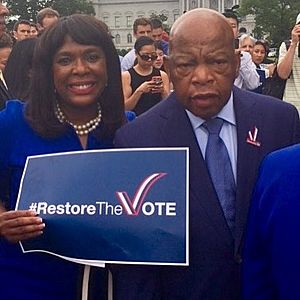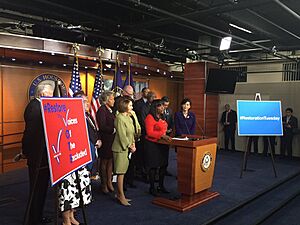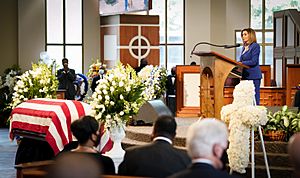John Lewis Voting Rights Act facts for kids
 |
|
| Full title | An Act to amend the Voting Rights Act of 1965 to revise the criteria for determining which States and political subdivisions are subject to section 4 of the Act, and for other purposes. |
|---|---|
| Introduced on | House: August 17, 2021 Senate: October 5, 2021 |
| Sponsored by | House: Terri Sewell (D-AL) Senate: Patrick Leahy (D-VT) |
| Number of co-sponsors | House: 223 Senate: 48 |
| Citations | |
| Public Law | 52 USC Ch. 103 |
| Effects and codifications | |
| Act(s) affected | Voting Rights Act of 1965 |
| Legislative history | |
|
|
The John R. Lewis Voting Rights Advancement Act of 2021 is a proposed law in the United States. It aims to make the Voting Rights Act of 1965 stronger. This act is named after John Lewis, a famous civil rights leader and politician.
The new law would bring back important rules that were changed by two decisions from the Supreme Court. These rules made sure that some states had to get federal approval before changing their voting laws. This process is called "pre-clearance."
The U.S. House of Representatives passed this bill on August 24, 2021. However, it did not pass in the Senate. It needed 60 votes to move forward, but it did not get them. A second try to pass it also failed in January 2022.
Contents
Why is this Act Important?
What is the Voting Rights Act of 1965?
The Voting Rights Act of 1965 (VRA) is a very important law. It was created to stop unfair practices that kept people, especially African Americans, from voting. Before this law, many states used things like voting tests to prevent certain groups from registering to vote.
A key part of the VRA was Section 5. This section said that states with a history of unfair voting practices had to get permission from the federal government before changing their election laws. This was called "pre-clearance." It helped make sure new laws would not harm anyone's right to vote.
The Shelby County v. Holder Decision
In 2013, the Supreme Court made a big decision in a case called Shelby County v. Holder. The Court decided that the way Section 4(b) of the VRA was set up was no longer fair. Section 4(b) was the part that decided which states needed federal approval for voting changes.
Because Section 4(b) was struck down, Section 5 (the pre-clearance rule) could not work anymore. This meant states no longer needed federal approval for their voting law changes.
How Voting Rules Changed After Shelby
After the Shelby County v. Holder decision, many states started making new voting laws. Some of these laws made it harder for people to vote. For example, Texas quickly put in place a strict voter ID law. Other states that used to need federal approval also added new voter ID rules.
Studies show that more people were removed from voter lists after this decision. This made it harder for some people to vote. For example, North Carolina passed a law that made voting harder in several ways. A court later said this law was designed to unfairly target African Americans.
To stop more unfair voting laws, the U.S. Government needed a new way to decide which states should have federal oversight. The John Lewis Voting Rights Act was created to do just that.
Voting Changes After the 2020 Election
After the 2020 Presidential Election, some states passed new laws that made voting more difficult. Many people believed these laws would especially affect minority voters.
What Does the Act Do?
Protecting Voters in Section 2
The John Lewis Voting Rights Act wants to make Section 2 of the original VRA stronger. This part of the law helps protect voters from discrimination.
Allowing Courts to Do More
The act also gives the U.S. Attorney General and courts more power. They could send federal observers to watch elections in certain areas. Courts could also stop new election rules in more situations if they seem unfair.
Bringing Back Federal Pre-Clearance
A main goal of the act is to bring back the "pre-clearance" rule. This means certain states would need federal approval for new voting laws again. The act creates a new way to decide which states need this approval.
Here's how the new rule would work:
- Any state that has had 15 or more voting rights problems in the last 25 years.
- Any state that has had 10 or more voting rights problems, and at least one was caused by the state itself, in the last 25 years.
- Any smaller area (like a county) that has had 3 or more voting rights problems in the last 25 years.
What counts as a "voting rights problem"?
- A court ruling that found voting rights were denied based on race or language.
- A court ruling that found an election law would have unfairly limited voting based on race or language.
- A court decision that stopped a new election rule from taking effect.
- The Attorney General stopped a new election rule from taking effect.
- A state or area changed a voting rule because it was challenged for being unfair based on race or language.
The Attorney General would keep an updated list of these problems. This list would help decide which states or areas need federal approval for voting changes.
| State | Covered by VRA of 1965 | Covered by John Lewis VRA |
|---|---|---|
| Alabama | As a whole | As a whole |
| Alaska | As a whole | Not covered |
| Arizona | As a whole | Not covered |
| California | Certain counties | As a whole |
| Florida | Certain counties | As a whole |
| Georgia | As a whole | As a whole |
| Louisiana | As a whole | As a whole |
| Michigan | Certain townships | Not covered |
| Mississippi | As a whole | As a whole |
| New York | Certain counties | As a whole |
| North Carolina | Certain counties | As a whole |
| South Dakota | Certain counties | Not covered |
| South Carolina | As a whole | As a whole |
| Texas | As a whole | As a whole |
| Virginia | As a whole | As a whole |
More Rules That Need Pre-Clearance
The bill would also make more types of election changes require federal approval.
Changes to Election Districts
Some changes to how election districts are set up would need federal approval. This applies if a state or area has a large number of racial or language minority voters. For example, if they change how many seats are elected at-large (meaning voters choose from a large group of candidates, not just one district).
Redistricting Rules
If a state or area changes its election district boundaries, it would need federal approval. This applies if the area has seen a big increase in its racial or language minority population since the last census.
Voter ID Rules
Any new voter ID rules that are stricter than current federal law, or stricter than when the John Lewis Voting Rights Act becomes law, would need federal approval.
Multi-Lingual Voting Materials
If a state or area wants to reduce or change how it gives out voting materials in different languages, it would need federal approval. This is unless similar changes are made to the English voting materials.
Voting Locations and Times
Changes that reduce or move voting locations, or shorten early voting hours (especially on Sundays), would need federal approval. This applies if the area has a large number of racial or language minority voters, especially on Native-American lands.
Voter List Maintenance
Any new reasons or processes for removing people from voter lists would need federal approval. This applies to states or areas with a large number of racial or language minority voters.
How the Act Would Be Enforced
The bill allows the Attorney General or any person to sue a state if they think it is avoiding federal pre-clearance. A special court panel would decide if a policy needs federal approval. Until the court makes a decision, the policy cannot go into effect.
What People Think About the Act
Support for the Act
Many people and groups support the John R. Lewis Voting Rights Advancement Act.
- Senators Raphael Warnock and Joe Manchin have spoken in favor of it.
- President Joe Biden has also asked Congress to pass the bill.
- Over 150 companies, including Amazon, Apple, Best Buy, and Target, signed a letter supporting the act.
Opposition to the Act
Some politicians, like Senate Republican Leader Mitch McConnell, are against the bill. They say it is not needed because they believe voting rights are not currently threatened. Some Republicans also argue that the act tries to give the federal government too much control over state elections.
History of the Bill
The John R. Lewis Voting Rights Advancement Act has been introduced in Congress several times. It was first called the Voting Rights Advancement Act of 2019. After John Lewis passed away in 2020, the bill was renamed in his honor.
In the 116th Congress, the bill passed the House of Representatives. However, the Senate, which was controlled by Republicans at the time, did not vote on it.
In the 117th Congress, the act was introduced again. It passed the House of Representatives but failed to pass the Senate. A later attempt to combine it with another voting rights bill also failed.




